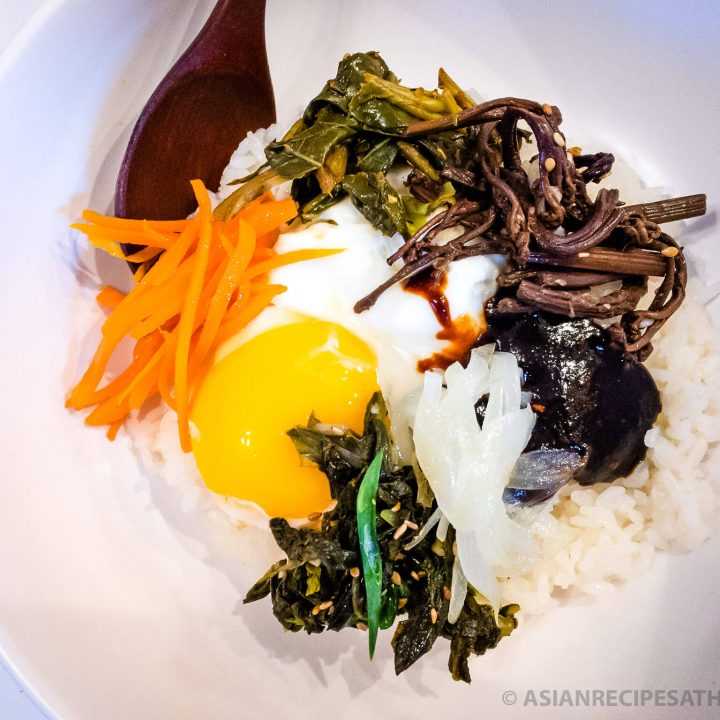This version of Korean bibimbap is full of a variety of vegetables, including poke salad (sallet), with a fried egg on top, and drizzled with a spicy gochujang sauce. Bibimbap is the ultimate Korean comfort food. This meal is easily transformable into a vegan meal or a gluten-free meal option with ingredient omission or simple ingredient swaps.
What is bibimbap (비빔밥)?
Bibimbap is probably the most well known Korean dish around the globe. Anyone who hears of bibimbap usually automatically knows that it is a very popular Korean dish. The term “bibim” means mixing various ingredients, while the “bap” noun refers to rice. Bibimbap is served as a bowl of warm rice, topped with various sautéed and seasoned vegetables (namul) or fermented vegetables (kimchi), raw or fried egg, sliced meat (usually beef), and a gochujang sauce. Soy sauce or fermented soybean paste (doenjang) will be used as well, however, the most common way to eat bibimbap is with the spicy gochujang sauce. The hot bowl with toppings is then stirred together right before eating.
Key tips and features
This bibimbap is meatless, however, you can add beef or even tofu if you would like to add in more protein. One of the great things about bibimbap is you can really customize the toppings to your liking. You can add meat, or you can make it completely vegetarian or vegan.
We love adding a lot of the spicy gochujang sauce to our bowls. However, that is what is beautiful about bibimbap bowls, you can add as little or as much of the spicy gochujang sauce as you’d like.
Transform this into a vegan meal
This meal is easily transformable into a vegan meal by omitting the fried egg on top. Make sure to also use an alternative for the Dasida beef powder soup stock. This mushroom umami powder would be a good alternative for the Dasida beef powder.
Transform this into a gluten-free bibimbap
Make this a gluten-free meal option for you and your family by simply ensuring that that the gochujang you use is gluten-free. Also, instead of using soy sauce, use gluten-free Tamari sauce. And we would recommend to also swap out the Dasida beef powder soup stock with a gluten-free umami booster, like this mushroom umami powder. That’s it!
What ingredients will I need to make this bibimbap recipe?
- Poke salad greens* (properly prepared/boiled – see our “how-to” post here)
- Dried fernbrake (gosari), (or 1 cup rehydrated)
- Carrots
- White/yellow onion
- Eggs (if vegan, omit)
- Olive oil
- Salt
- Dasida beef powder soup stock (if you want to make this a vegan/vegetarian or gluten-free recipe, substitute the Dasida with a mushroom umami powder)
- White rice
- Sesame oil
For the Bibimbap Gochujang Sauce:
- Gochujang (ensure the gochujang you’re using is gluten-free if needing to stay gluten-free, like this one)
- White vinegar
- Soy sauce (use Tamari instead for a gluten-free option)
- White sugar
- Toasted sesame seeds
Let’s make Korean Bibimbap with Poke Salad (Sallet)
Before we get started, please ensure you have properly prepared poke salad greens ready to go. Remember, never eat poke salad in its raw form & it must be properly prepared before using in any recipe, even this recipe. If you want to learn more about the process of properly preparing pokeweed in detail, then look at our dedicated post here. If you do not have properly prepared poke salad (sallet) greens ready to go, then we suggest you prepare the poke salad (sallet) greens first, and then come back to this recipe as our process is about a 48-hour process. You can also omit the poke salad (sallet) greens if you are pressed for time, or do not have access to poke salad (sallet) greens. Always use poke salad (sallet) greens at your own risk.
Step 1: Make the spicy gochujang sauce
First, let’s make the sauce so it’s ready to go. Mix all the ingredients for the sauce together in a small bowl. Set aside.
Step 2: Stir fry each of the vegetables separately and set aside
Next, we are going to stir fry all of the vegetables separately in a pan over medium/medium-high heat. Once each vegetable is done, set each aside in separate piles on a large plate, or in their own separate little bowls.
Let’s get started. Stir fry the properly prepared/boiled/soaked poke salad greens for about 7 minutes and add ¼ tsp of salt plus a pinch of Dasida beef powder stock (make sure all liquid has evaporated). Once the liquid has evaporated, remove the poke salad from the pan onto a plate or bowl and set aside.
Stir fry fernbrake (gosari) for about 7 minutes and add ¼ tsp of salt plus a pinch of Dasida beef powder stock (make sure all liquid has evaporated). Once the liquid has evaporated, remove the fernbrake (gosari) from the pan onto a plate or bowl and set aside.
Stir fry onion for about 7 minutes and add ¼ tsp of salt plus a pinch of Dasida beef powder stock. Remove the onion from the pan onto a plate or bowl and set aside.
Stir fry carrots for about 3 minutes and add ¼ tsp of salt plus a pinch of Dasida beef powder stock. Remove the carrots from the pan onto a plate or bowl and set aside.
Step 3: Fry the eggs sunny side up style
In the same frying pan as you cooked the vegetables in, add a bit more oil. Cook each of the eggs sunny side up. Set eggs aside for later.
Step 4: Assemble the bibimbap bowls and enjoy!
Assemble the bowls with the rice at the bottom. Place a little bit of each vegetable along the sides of the bowl on top of the rice. Place the egg on top in the center of the bowl. Drizzle a bit of sesame oil on top of each egg. Then add the bibimbap gochujang sauce based on your spice preference. Enjoy!
We hope you enjoy our Korean Bibimbap with Poke Salad (Sallet) recipe!
Need more side dish (banchan) recipes?
- Easy Asian Pan-Fried Zucchini
- Korean Spicy Stir-Fried Eggplant
- Easy Napa Cabbage Korean Kimchi – Cut-Up Kimchi
- Stir-Fried Poke Salad (Sallet) Stems
HUNGRY FOR MORE? Subscribe to our newsletter and follow along on Facebook, Pinterest, Twitter, and Instagram for all of the latest updates.
This version of Korean bibimbap is full of a variety of vegetables, including poke salad (sallet), with a fried egg on top and drizzled with a spicy gochujang sauce. *If you do not know how to properly harvest and prepare pokeweed to remove the toxins prior to use in any recipe, then please do your own research on the topic first & use it at your own risk. There are a ton of resources and how-to's online with a simple Google search. We have our own how to harvest and prepare pokeweed post here as well. It explains how we prepare pokeweed prior to using it in any recipe. **If you want to make this a vegan/vegetarian or gluten-free recipe, substitute the Dasida with a mushroom umami powder like this one and omit the eggs. ***For gluten-free, use a gluten-free Tamari sauce instead of soy sauce & ensure the gochujang you are using is gluten-free friendly. 
Korean Bibimbap with Poke Salad (Sallet)
Ingredients
For the Gochujang Sauce:
Instructions
Notes
Disclaimer: Under no circumstances shall this website and the author(s) be responsible for any loss or damages resulting from the reliance of the given nutritional information or ingredient/product recommendations. Recommended ingredients/products can change their formula at any time without this website and author’s awareness. It is your responsibility (the reader’s) to check the label/ingredients of any product prior to purchasing and/or using. We greatly appreciate your support and understanding.


